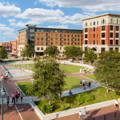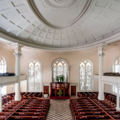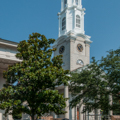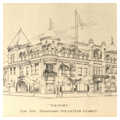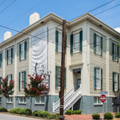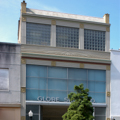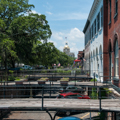Few cities in America enjoy so distinctive an urban identity as Savannah, with its squares and broad streets, its trees and bordering marshes, and its remarkable state of preservation. Yet it is also a place marked by paradox. Founded in 1733 as an agrarian colony of equals, the city prospered greatly from industry, trade, and slavery. Its urban plan attracts worldwide attention, yet few of its buildings are famous or appear in histories of American architecture. Historically a relatively small city with a population in 2015 of about 150,000, Savannah has nonetheless played a significant role on the national stage in terms of the religious, military, agricultural, transportation, and industrial history of the country. Most recently the city has served as a model of historic preservation and urban design for both American and foreign preservationists and planners.
Efforts to preserve the city's character date back to the 1790s, when the first expansion of the colonial city replicated the original ward module devised by James Oglethorpe, establishing a pattern repeated by subsequent generations of civic officials. General Sherman's decision to occupy but not destroy Savannah in December 1864 stands as a significant moment of preservation in its history and contrasts the devastation the war brought to nearby Atlanta, Charleston, and Columbia, South Carolina. Stewardship of the city's history was dramatically enhanced by the founding of the Georgia Historical Society in 1839, nurturing generations of historians and amateur architectural historians to document the city's heritage. Among the most active was Thomas Gamble, who moved to Savannah in 1888 and became a newspaper reporter, eventually holding various positions in city government before serving several terms as mayor, beginning in 1933. In 1921, he mobilized the city's first preservation group, the Society for the Preservation of Parks, in an effort to stop U.S. 17 from cutting through Franklin, Liberty, and Elbert squares on Montgomery Street. That proposal prompted an ongoing battle until the automobilists prevailed in 1935, the same year the short-lived Savannah Commission for the Preservation of Landmarks was established. During the 1930s, Works Progress Administration WPA programs in the city focused on various projects that further documented the past and the present, including the Historic American Buildings Survey and a Cadastral Survey preserved at the Chatham County Superior Court Records Room which documented every property in the city and laid the groundwork for the efforts of building preservationists after World War II.
During the 1950s through the 1970s, American cities grew at an unprecedented rate, with suburbs sprawling across the countryside and historic downtowns replaced by large-scale buildings and parking lots, all in the name of progress. Savannahians shared in the heady enthusiasm for modernization, extending the city's boundaries far to the south. Unlike most other cities, however, here the interstate highway system played little role in this growth. In downtown, meanwhile, the demolition of architectural landmarks—the Wetter House in 1950, the City Market building in 1954, Union Station in 1963, the Hotel Desoto in 1966, and the block of warehouses beside City Hall in 1969—stirred the forces of civic pride. Established in 1955, the Historic Savannah Foundation HSF, under the leadership of Leopold Adler II, successfully saved hundreds of buildings, mostly houses, using an innovative "revolving fund" to purchase threatened properties and then sell them to buyers committed to their preservation, a strategy that would become a national model. The HSF continues to advocate for the protection of the city's heritage. Private preservationists, notably Jim Williams and Mills B. Lane Jr., saved numerous houses during the 1970s, a tradition carried on by Lane's son, Mills B. Lane IV, who used his philanthropic Beehive Foundation to support numerous restoration and urban renewal projects. Meanwhile, Walter Hartridge Jr., president of the Georgia Historical Society from 1952 to 1961, rescued and preserved records documenting the city's heritage.
Most unusual within the broader panorama of the historic preservation movement nationwide was the establishment of the Savannah College of Art and Design SCAD in 1978, repurposing the old Savannah Volunteer Guards Armory. Since that time, the college has found new uses for more than sixty historic buildings scattered throughout the city. As of 2015, Savannah boasts one of the country's largest National Historic Landmark districts, twelve National Register districts, and three districts with design review procedures integral to the development process. As is evident in its varied buildings, landscapes, monuments, squares, and parks, Savannah remains a living city, balancing new and modern designs with the ongoing preservation and adaptive reuse of the past.
Writing Credits
If SAH Archipedia has been useful to you, please consider supporting it.
SAH Archipedia tells the story of the United States through its buildings, landscapes, and cities. This freely available resource empowers the public with authoritative knowledge that deepens their understanding and appreciation of the built environment. But the Society of Architectural Historians, which created SAH Archipedia with University of Virginia Press, needs your support to maintain the high-caliber research, writing, photography, cartography, editing, design, and programming that make SAH Archipedia a trusted online resource available to all who value the history of place, heritage tourism, and learning.

